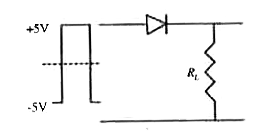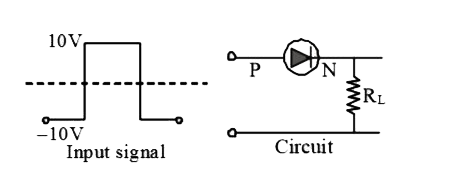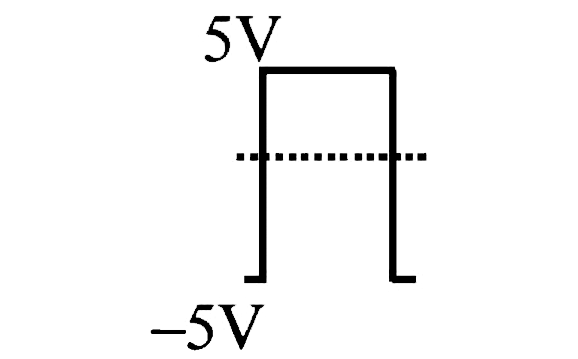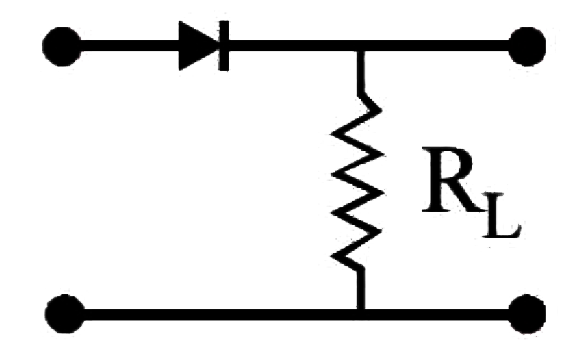If a p-n junction diode, a square input signal of 10V is applied as shown,

then the output signal across RL will be
 Solution in Telugu
Solution in Telugu
The junction diode will conduct when it is forward biased. Therefore, the output voltage will be obtained during positive half cycle only. So correct option is (3).
Topper's Solved these Questions
- SEMICONDUCTOR DEVICESBOOK - AAKASH SERIESCHAPTER - SEMICONDUCTOR DEVICESEXERCISE - EXERCISE -I (ENERGY BANDS AND CLASSIFICATION OF SOLIDS )
43 Videos
- SEMICONDUCTOR DEVICESBOOK - AAKASH SERIESCHAPTER - SEMICONDUCTOR DEVICESEXERCISE - EXERCISE -I (P-N JUNCTION DIODE)
35 Videos
- SEMICONDUCTOR DEVICESBOOK - AAKASH SERIESCHAPTER - SEMICONDUCTOR DEVICESEXERCISE - Problems (LEVEL-II)
7 Videos
- RAY OPTICSBOOK - AAKASH SERIESCHAPTER - RAY OPTICSEXERCISE - PROBLEMS ( LEVEL-II)
50 Videos
- UNITS AND MEASUREMENTBOOK - AAKASH SERIESCHAPTER - UNITS AND MEASUREMENTEXERCISE - PRACTICE EXERCISE
45 Videos
Similar Questions
Carbon, silicon and germanium have four valence electrons each. These are characterised by valence and conduction bands separated by energy band gap respectively equal to (Eg)c,(Eg)Si and (Eg)Ge .Which of the following statements is true ?
(a) (Eg)Si<(Eg)Ge<(Eg)C
(b) (Eg)C<(Eg)Ge>(Eg)Si
(c ) (Eg)C>(Eg)SI>(Eg)Ge
(d) (Eg)C=(Eg)Si=(Eg)Ge
View SolutionThe neutral region formed at P-n junction due to recombination of electrons and holes is
View SolutionA n-type silicon sample of width 4×10−3m, thickness 25×10−5m and length 6×10−2m carries a current of 4.8 mA when the voltage is applied across the length of the sample. If the free electron density is 1022m−3, then find how much time does it take for the electrons to travel the full length of the sample? Given that charge on an electron e=1.6×10−19C
View SolutionTwo plane mirrors are combined to each other such that one is in y-z plane and the other is in X-z plane. A ray of light travelling along a vector ˆi+ˆi+ˆk is incident on the first mirror. Find the unit vector in the direction of emergent ray after successive reflections through both the mirrors.
View SolutionThe ratio of S.I. unit of universal gravitational constant to C.G.S. unit is
View SolutionIf an a p-n junction, a square input signal of 10V is applied, as shown then the output across R_(L) will be
View SolutionIf a p-n junction diode, a square input signal of 10 V is applied as shown. Then the out put signal across R_(L) will be .
View SolutionIf the following input signal is sent through a P-N junction diode, then the output signal across RL will be -

View SolutionIf in a p - n junction diode , a square input signal of 10 V is applied as shown

Then the output signal across RL will be
View SolutionIf in a p - n junction diode , a square input signal of 10 V is applied as shown Then the output signal across R_L will be
View SolutionIf in p-n junction diode a sinusoidal input signal is applied as shown
(##∀KP7N∃TPHYSP7C29E01008_Q01.png width=80%><br>ThentheoutputsignalacrossR_(1) will bw
View SolutionIf in a p - n junction diode , a square input signal of 10 V is applied as shown : Then the output signal across R_L will be :
View SolutionDraw the output signal in a p-n junction diode when a square input signal of 10 v as is applied across it

View SolutionIf in a p−n junction diode , a square input single of 10V is applied as shown


View SolutionIf a p-n junction diode, a square input signal of 10V is applied as shown, then the output signal across R_(L) will be.
View Solution
